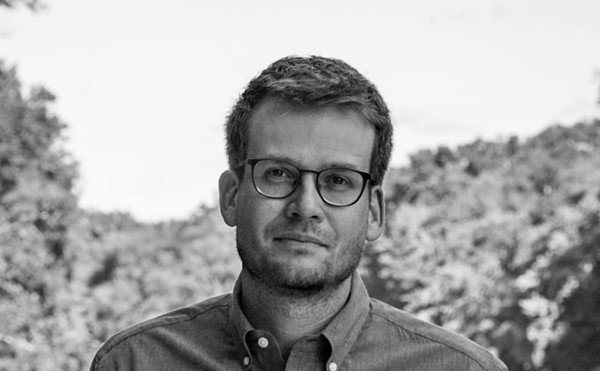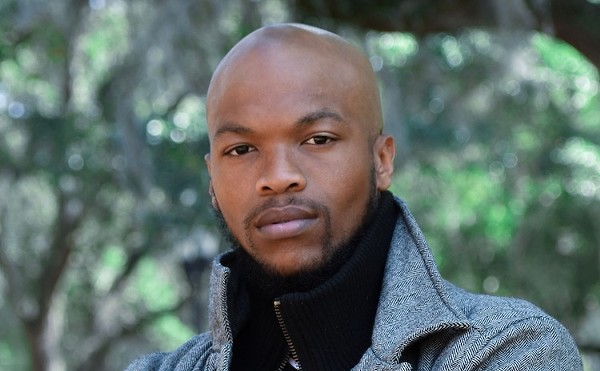'The AIDS virus is just a virus. It has no personal agenda against me. It's just another creature in God's creation." So said visionary painter Frank Moore, an artist who made his illness a focal point of his life's work, in an interview with the New York Academy of Sciences shortly before his death.
When Moore, who died in April at age 48, learned he was HIV-positive 17 years ago, the diagnosis actually seemed to bolster his confidence as an artist -- as well as inspiring him to environmental and social activism. As one member of his family privately says, "He acquired depth as an artist as he met the AIDS crisis head on -- as he assessed its emotional and physical toll, and plumbed its political and economic dimensions."
A self-described "flower child" during his youth in the Adirondacks in the 1960s, Moore was always fascinated by the natural world and how modern science could alternatively support it and destroy it. While many artists perceive science and technology to be enemies of art, Moore decided to explore and even embrace them. "My experience with science -- especially pharmaceutical science -- has been very positive," he told the Academy of Sciences. "Let's face it, genetically engineered formulations have kept me alive." And his long personal and public battle to stop the "demonizing" of AIDS inspired an often disturbing but always optimistic artistic vision.
A surrealist grounded in the brushstrokes of reality, Moore described his work as "providing a visual forum for people to reflect on what their relationship with nature is. I believe you cannot have healthy people in an unhealthy environment and you can't have a healthy environment where unhealthy -- greedy, exploitative -- people predominate."
Many of his paintings reflect some kind of battle between nature and its spoilers. A dramatic series set at Niagara Falls stems from a trip Moore took there. Submerged in mist during a tour-boat ride, he wondered about the water's makeup. He did some research and found that the EPA was monitoring more than 350 harmful chemicals in the river. In his paintings "Niagara 1994" and "Niagara 1995," he included alchemical symbols to represent mercury and other pollutants that have corrupted the water. (He frequently incorporated scientific symbolism, including DNA molecules, in his pictures.) In the Niagara-related "Maid of the Mist" (1994-95), he depicted raingear-clad tourists on the boat as monks ministering the last rites at a sacred site.
Moore's AIDS-themed pieces almost always include a note of hopefulness. In "Freedom to Share" (1994), a mother and father have gathered their multiracial family for a Thanksgiving feast; the turkey is made entirely of pills -- with twin syringes of "AIDS cocktails" in the place of the drumsticks. The children eagerly await their portions of the bird's bounty. And, in "Beacon" (2001), Moore shows us a young man in a hospital bed, drifting in a turbulent electric-blue sea. As unsettling as the image is, there are lifelines: an octopus tentacle offering a syringe and a human hand rising up with a bottle of pills.
While Moore's distinctive style is well known in New York, where examples of his work hang in the Museum of Modern Art and the Whitney Museum of American Art, his name is not yet a household word outside of his home state. But one of his creations has become internationally renowned. In 1991, working with the advocacy group Visual AIDS, Moore came up with a concept to advance the cause. "My neighbors in upstate New York had a daughter in the Gulf War, and they tied a yellow ribbon around a tree," he explained in a
1997 newspaper interview. "I took that idea and suggested we turn it into something you could wear." Before long, the AIDS red ribbon had become the world's most recognizable lapel accessory, raising millions of dollars and a great deal of public awareness.
In recent years, Moore downplayed his role in the ribbon's development, describing it as a "collaborative effort" with others on the Visual AIDS team. He didn't want his fellow activists to think he was hogging the glory for a project that took a lot of teamwork.
Despite occasional health scares from opportunistic infections, a lot of good things were coming together for Moore at the outset of this year. There was a new book, "Between Life and Death" (Twin Palms Publishing), the first oversized monograph of his work; it was published just two weeks ago. Then there were plans for a major tour of his paintings: "Green Thumb in a Dark Eden." In addition to being presented by the prestigious Albright-Knox Art Gallery in Buffalo, the show was coming to the Orlando Museum of Art -- his first significant exposure in Florida.
That pleased Moore, and he hoped to be able to attend the June 8 opening. "He was thrilled about Orlando," says Sue Scott, adjunct curator of contemporary American art for the museum. "He died a happier person knowing that his work would be here."
Scott is a longtime fan of Moore's art, having discovered him in 1994 in New York, where the renowned Sperone Westwater Gallery presented his first significant exhibits. (The gallery still represents him.) After "many, many years" of trying -- a task made difficult because of "high demand" for his work -- Scott was finally able to acquire one of the artist's last paintings for the museum's permanent collection. "Black Pillow" (2002), which is making its debut in the current show, depicts a young farmer leaning against the frame of the picture, spraying a nozzle filled with oily petroleum onto a cornfield. The ears of corn themselves are computer keyboards. It is a wry commentary on the fact that up to six gallons of fossil fuel are required to produce a single bushel of corn.
Moore frequently had fun with the framing of his pictures, particularly his largest pieces. His "Niagara 1994" (99 by 67 inches) is surrounded by copper water pipes with protruding faucets. "Oz" (2000, 62 by 56 inches), a rather grim study of the tornadolike effects of human spoilage and animal abuse, is framed by a road map of the state of Kansas.
"Frank worked in a highly realistic style that brings to mind the beautiful surfaces of the Old Masters," Scott says. "And yet, beneath the seductive veneer is often a commentary on the darker side of contemporary life." The "Green Thumb in a Dark Eden" exhibit, a retrospective of his works since 1989, reflects both sides of what he called his "sweet and sour" outlook on mankind's relationship to his environment. The bright side focuses on "nurturing gardens," with references to the cultural myths of Eden, Arcadia and Shangri-la. The darker side is represented by "anti-gardens: spaces which are disordered, decaying, toxic, depressing, stressful and raw." Moore described it as a "conundrum of life today that many of these images function on both levels: sites of great, but toxic, beauty."
One of his most potent AIDS-related works evolved from a walk in the woods he took near his rural home outside of Binghamton, N.Y., in the late 1990s. Moore noticed plants growing from a rotting, fallen tree. In his painting, "Release," the tree becomes an outstretched arm covered with bloody sores and lesions, but sprouting from them are new plant life; and the decaying hand releases colorful butterflies. The image reveals a microcosm of regeneration, life rising from the harshness of death: an eco-system in balance.
Although he always wanted to be an artist and earned a bachelor's degree in painting from Yale University, Moore almost gave up applying oils to canvas in the late 1970s in favor of a career in the performing arts. While living in Paris, a friend took him to see Merce Cunningham's dance company. One member of the troupe proposed that Moore collaborate with him in creating a dance piece, and Moore obliged. He enjoyed the work; and for several years he did costuming and set design and construction for numerous theatrical and dance companies, including the Joffrey Ballet. But he ultimately chose the tranquility of painting to the constant deadlines of the theater.
Not that his paintings from the '80s were particularly tranquil. His lover became seriously ill with AIDS, and the couple had to fight with insurance companies over treatment and compensation. The feuds led Moore to do a series of angry pieces inspired by insurance advertisements -- images of broken windowpanes falling in on shattered lives, and of sharks attacking unwary swimmers.
Then, when he was in his early 30s, Moore learned of his own HIV-positive status. In his artwork, AIDS "came to the fore," he explained, "simply because it was affecting every aspect of my life."
That included his political consciousness. He became active in the then-fledgling group Visual AIDS (thebody.com/ visualaids/text.html), which raises money to provide direct services to artists living with HIV/AIDS. In addition to his contributions to the Ribbon Project, he helped launch its Archive Project in 1994. The aim has been to provide free photo-documentation of artists' work, to ensure that their cultural legacies would be preserved -- and to provide a visual record of the AIDS pandemic for future generations. The project also provides grants for materials to low-income artists, offers exhibits and educational programs, and assists with estate planning.
Moore also was instrumental in the development of the Estate Project, organized by the Alliance for the Arts in New York (www.artistswithaids.org), to document and preserve works created by people with AIDS in all areas of creative endeavor from dance to music to filmmaking.
In his final months, in addition to completing a surge of new paintings, Moore was working to establish his own philanthropic organization, the Gesso Foundation. Named for the substance painters often use for a base coating on their canvases, the foundation will manage his art, place it for maximum public enjoyment, and use the proceeds from exhibitions, books and other sales to assist worthwhile causes. According to Rebecca Moore, Frank' sister who is helping to organize the foundation, "Frank didn't leave a lot of money, but he wanted it to go where a little money means a lot. He wanted to give grants to organizations working for social justice, AIDS and environmental issues." The foundation's website, www.gesso.org, will be online soon.
In many ways, Frank Moore lived his last two decades by an old adage: It's not how much time you have to spend, it's how you spend your time that counts. And the harder he worked, the more confident he became in his ability to connect with people through painting.
Not long before his death, an interviewer asked him if he really believed that art can change anyone's mind.
Snapped back Frank Moore, "It's changed mine."















